A Budget Home Theater & PC Setup: 4K, HDR, UHD Blu-ray, and More
by Ganesh T S on December 26, 2017 8:30 AM ESTLocal Media Playback
Our typical HTPC testing flow involves playing back files encompassing a range of relevant codecs, containers, resolutions, and frame rates. A note of the efficiency is also made by tracking GPU usage and power consumption of the system at the wall. Over the last year or two, the focus has been on using Kodi and MPC-HC with its built-in LAV filters for benchmarking. Even though we have had non-HDR 4K clips for some time now in our test suite, we have not subject them playback at native resolution. In order to augment our test suite, we have added two files, a 4Kp25 HEVC HDR stream in a MKV container, and a 4Kp60 VP9 Profile 2 HDR stream in a WebM container.
Out of all the options we evaluated, the TCL 55P607's in-built Roku platform is the only one capable of handling Dolby Vision videos. However, when we tried to play back a sample file, the Roku interface stalled in the retrieving stage after the appearance of the Dolby Vision logo.
The TCL 55P607 Roku Media Player App - Unable to Handle Local Dolby Vision Files
Due to the absence of reliable open-source editing and decoding tools for Dolby Vision in the PC space, its testing with local media files will have to wait.
The Roku Media Player app continues to be a disappointment for users with anything other than the standard H.264 / HEVC-based camcorder files. The following recorded clip shows its failure with some interlaced MPEG-2 and H.264 clips in TS containers. VC-1 is also not supported.
On the plus side, we have automatic switching to HDR for local files which have HEVC HDR content. On the othr hand, a VP9 Profile 2 HDR clip did not generate the mode switch.
We tracked the power consumption of the TV while the Roku interface tried playing back the various files in our test suite. It was not much of a surprise to find that Roku fails to play back many of the streams. The graph segments below corresponding to the files that didn't play back are just the display remaining idle in the Roku USB Player interface.
The NVIDIA SATV supports all files in our test suite except the one encoded in VP9 Profile 2. With Kodi, we even see the HEVC HDR file being decoded and sent to the display with the appropriate mode switch.
The NVIDIA SHIELD Android TV Supports HDR Playback with Local Files
The power consumption of the SATV was tracked during the playback of each file in our test suite using Kodi 17.6. The segment corresponding to the VP9 Profile 2 file is just the duration for which the audio track was decoded and the Kodi UI remained idle.
Moving on to the PC space, we first compare the DXVAChecker outputs for the three systems. The Zotac EN1080K with its GTX 1080 GPU does not support hardware decoding of VP9 Profile 2 videos. Even if a HDR stream were to be available, the system plays back only the non-HDR versions with the desktop in HDR mode.
The Absence of VP9 10-bit Profile 2 Decoding in the GTX 1080 is the Only Odd Spot (from L to R: ASRock Beebox-S 7200U, Zotac ZBOX MAGNUS EN1080K, and the Intel NUC7i7BNHX1)
We found the native Microsoft Movies & TV app to be capable of playing back HDR videos with the desktop in HDR mode. A comparison of playback using two different players in that mode is shown below.
However, the playback of HDR files in non-HDR mode using the Microsoft Movies & TV App results in messed up colors. As such, we don't recommend the Movies & TV app for HDR file playback under all circumstances.
It is possible to use the madVR renderer in conjunction with a suitable player to shift the display to HDR mode independent of the OS setting. It is also supposed to bring the display back to the original state when exiting. We tested it out with MPC-HC and madVR v0.92.10 on the Zotac EN1080K. On the KBL-U systems, using madVR as the renderer resulted in evident dropped frames irrespective of the setting. On the Zotac EN1080K, we found that the latest NVIDIA driver release (which we absolutely had to use for Netflix 4K playback) seemed to have some issues with the restoration of the previous mode. With certain settings, the colors seemed to get crushed significantly after madVR triggered the mode change.
In fact, the only reliable combination in which we could get playback of the files in the appropriate mode was to set the OS toggle for HDR, and allow madVR to pass through the HDR metadata directly to the display (something that the madVR author specifically mentions as unsuitable for purists). We do not have automatic mode switching or even identification of HDR when using Kodi (as of v17.6). With madVR and MPC-HC, it is possible, but the consumer experience may vary.
In our opinion, HDR local media playback is yet to reach a stable state with commonly used software combinations. CyberLink's PowerDVD 17 also supports automatic HDR mode switch for playback of local files on Intel GPU-based systems. We found that it worked well in both of the KBL-U PCs, but, PowerDVD unfortunately refused to play back the VP9 Profile 2 files on those systems.
The power consumption of the three PCs during the playback of each file in our test suite using Kodi 17.6 was recorded. The same was done using the Microsoft Movies & TV app also, but, we found significant power consumption change (up to 10W at the wall) when the control overlay appeared on the screen. As such, we believe that the Microsoft Movies & TV app is not a reliable way to determine media processing efficiency of any system.
A similar graph for the madVR playback case in the Zotac ZBOX EN1080K (with OS HDR toggle set and madVR configured for HDR passthrough in full screen windowed mode) is presented below.
The power consumption numbers were also graphed for the PowerDVD playback case using the two KBL-U systems.
In general, we find that the Zotac system consumes a lot of power, but, it also performs a lot better compared to the KBL-U systems when advanced HTPC requirements like madVR rendering are considered. The HDR ecosystem is just getting started and we are waiting for things to reach a more matured state before doing a detailed analysis of the playback of local HDR files in PCs.


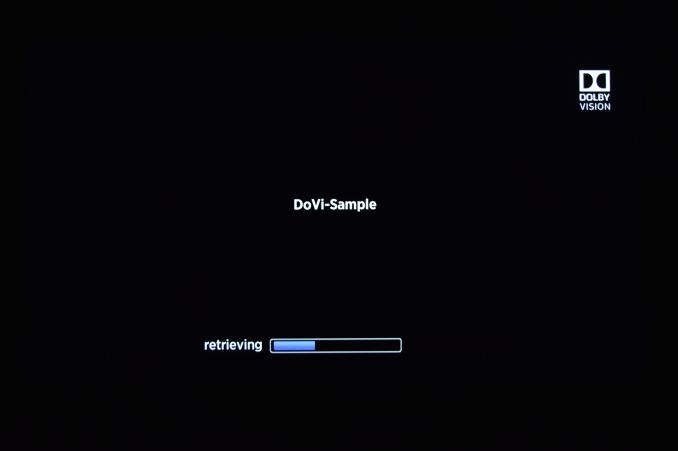

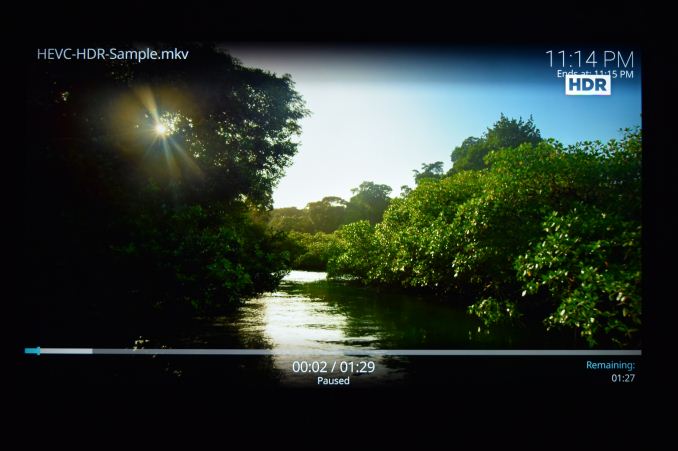
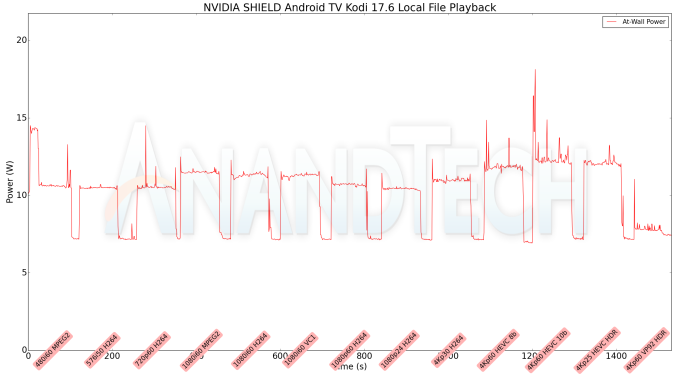
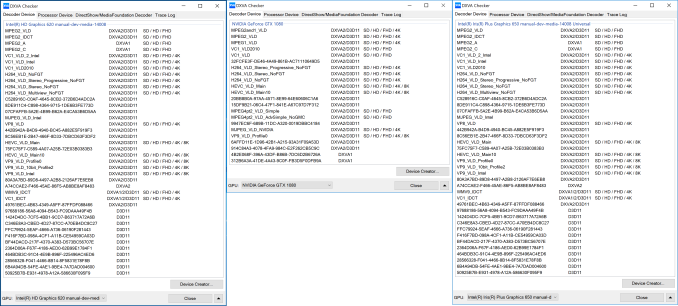
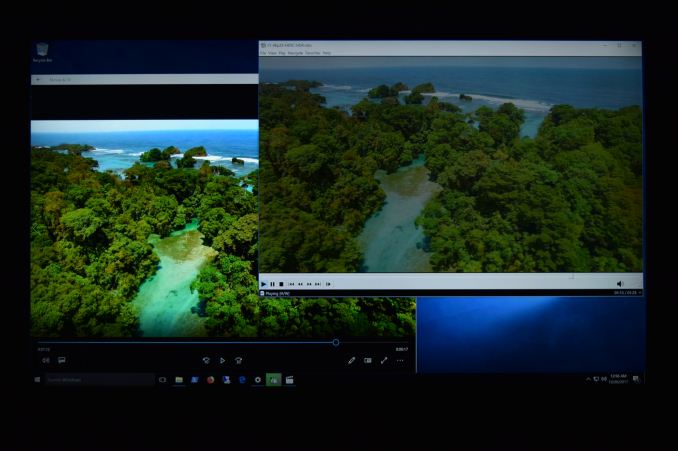
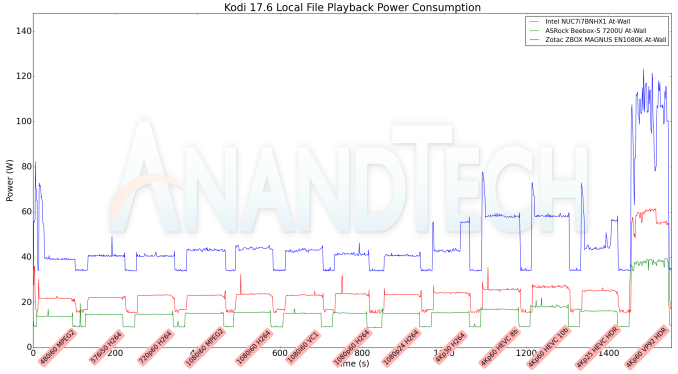










191 Comments
View All Comments
Azethoth - Monday, January 1, 2018 - link
Why don't you go read an article on _not_ home theater, and regale everyone with how awesome the sound from your shitty TV speakers are. Home theater is simply not for your budget, but don't pretend everyone is living in mom's basement.This article may be out of touch with the 5 of you, but it is not out of touch with the rest of the readers.
Why not go whine in articles about supercars about how they are out of touch with 99.999999% of the planet. Oh noes! I still want to read about them though.
Sivar - Wednesday, January 3, 2018 - link
Most Anandtech readers are tech-savvy, but not tech experts and have normal homes, eyes, ears, and middle-level income (of those in the United States).Talk of an OLED TV or projector tells me that it is you who is out of touch with readers, and it doesn't help that your statement to the author was inappropriately rude.
OLED TVs have an objectively better picture quality, but are much more expensive and the difference is not that noticeable to most people.
Projectors are great (I use one) but are impractical for many (most?) homes because they need light control and, for good pricing, a large flat wall for the screen.
Regarding speakers, if the implication is that there is no noticeable difference between them, then yI suspect you are not at all an enthusiast of home theater. This isn't even a reasonable debate, it just leaves me dumbfounded. True that there is little difference between an extremely fancy speakers (say from Focal or Magico) and a good set of well-designed towers such as those from Ascend or JBL, and indeed the audio industry has a lot of snake oil like expensive cables and any Bose product, but to say that a speaker "works or it doesn't" proves little experience with sound systems, even in the sub-$500 range.
SunnyHours - Wednesday, July 11, 2018 - link
Totally agree with you there!Especially your comment about Cables, Bose (I HATE BOSE!) and mostly the comment that "either a speaker works or it doesn't" that just really surprised me and made me wonder how this person can even entertain the idea of giving tips on a subject you know nothing about...especially on the internet where people will put you on the spot and call you for being an ignorant person and at the same time being a "know it all".
Next thing he will say is that "Vinyls sound like crap and cassettes were a much improved product" LOL.
Dug - Friday, January 5, 2018 - link
He's not out of touch. A good balanced receiver will last much longer in a system than video. Most people upgrade video (tv's, monitors, etc), than they do sound. Projectors don't really fall into the family room scenario either. Usually too much light, sound, maintenance, setup, etc. Plus there's no real 4k hdr affordable projectors out.Bullwinkle-J-Moose - Thursday, December 28, 2017 - link
"So you want a home theater system but don't want to get an AV receiver?"-----------------------------------------------------------------------------------------------------
Why not?
I have a 35 Watt dual-core Sandy Bridge with optical audio output to my Digital EQ (Behringer DEQ24/96) and Balanced XLR to each JBL LSR305 powered monitor
(Behinger AD converters sound like crap but with an optical input, it sounds Fantastical)
Much better than a Denon receiver I do believe
Sure, it's completely Gimped when its running Windows 10 DRM garbage
But, if I want to run 4K on a Gimped System, I can boot to 7 / 8.1 or Spyware Platform 10
I'm running Windows XP right now so I don't need to worry about Bluescreens of Death, malware, or Viruses like I do with Spyware 10
Burns BlueRay Disks fine and can boot to a stock install of XP in 3-4 seconds from a Samsung 850 Pro
Any computer newer than Sandy Bridge is nothing more than a Locked Down Gaming Console with a web browser attached and they make for really piss poor home theater setups
"Personal" Computers died with Sandy Bridge!
You are just renting a JukeBox
Azethoth - Monday, January 1, 2018 - link
I am missing the part where your "fantastical" Behringer DEQ24/96 decodes Dolby Surround.You are failing at Home Theater. There are standards. One of them is surround sound.
Stereo is for listening to old timey music. I am willing to put my Denon in surround stereo up against your stereo thing anytime. I will also pretend that Denon is better, except it would actually be true unlike your imaginings where an optical in somehow makes a difference.
Just so you know, hard science and engineering tells us that an optical in connection means you 100% do not have what this article is about: the more part of 4k blu ray. Atmos does not fit into optical. Hell, 7.1 and 9.1 surround did not fit.
So you and the rest here are just bloviating without saying anything relevant to the topic.
tl;dr If it is beyond your budget, quit whining and read the follow up article next year. Everything will be cheaper and better.
Bullwinkle-J-Moose - Monday, January 1, 2018 - link
"I am missing the part where your "fantastical" Behringer DEQ24/96 decodes Dolby Surround.You are failing at Home Theater. There are standards. One of them is surround sound."
--------------------------------------------------------------------------------------------------------------------
There is no "Standard" to Home Theater!
Surround Sound is one of many so called "Standards"
Your "Budget" demands "Your Standards"
3.1 / 5.1 / 7.1 / 9.1 are simply additions to the 3.0 "Standard" that I created over 30 years ago
They do not Image a "Standard" stereo output as well as mine and yet you claim "They" are the "Standard"
Advertising propaganda has taught you well
Now go forth and spew nonsense
A "Budget" Home Theater can be whatever you want it to be
Racing Stripes and RGB lighting may cost extra
Reflex - Monday, January 1, 2018 - link
I am unclear on how your setup will do positional audio in a home theater setup. For instance, if I play back DD5.1 content, will your setup put the appropriate audio and effects behind a viewer? If I play Dolby Atmos or DTS X content, will it additionally place the appropriate audio above the viewer's head? If so, how are you handling the decode operation for those standards to translate them to your proprietary speaker number and arrangement?Thanks!
Bullwinkle-J-Moose - Tuesday, January 2, 2018 - link
"If I play Dolby Atmos or DTS X content, will it additionally place the appropriate audio above the viewer's head? If so, how are you handling the decode operation for those standards to translate them to your proprietary speaker number and arrangement?"-------------------------------------------------------------------------------
I support my original "Reference Standard" which preceded Atmos and DTS X
I do not support other "Non-Standards" which came later
The only way a "Non-Standard" Home Theater experience can match the "Stereo" Imaging accuracy of my Reference "Standard" is to steal my design
If Dolby or anyone else can claim to match the Imaging accuracy of my Reference Design, then there are really only two possibilities here that I can see
A: They stole my design
or
B: They are Liars
There either ONE Reference, or there is no reference
Choose Now!
Bullwinkle-J-Moose - Tuesday, January 2, 2018 - link
There is either ONE Reference, or there is no reference at all